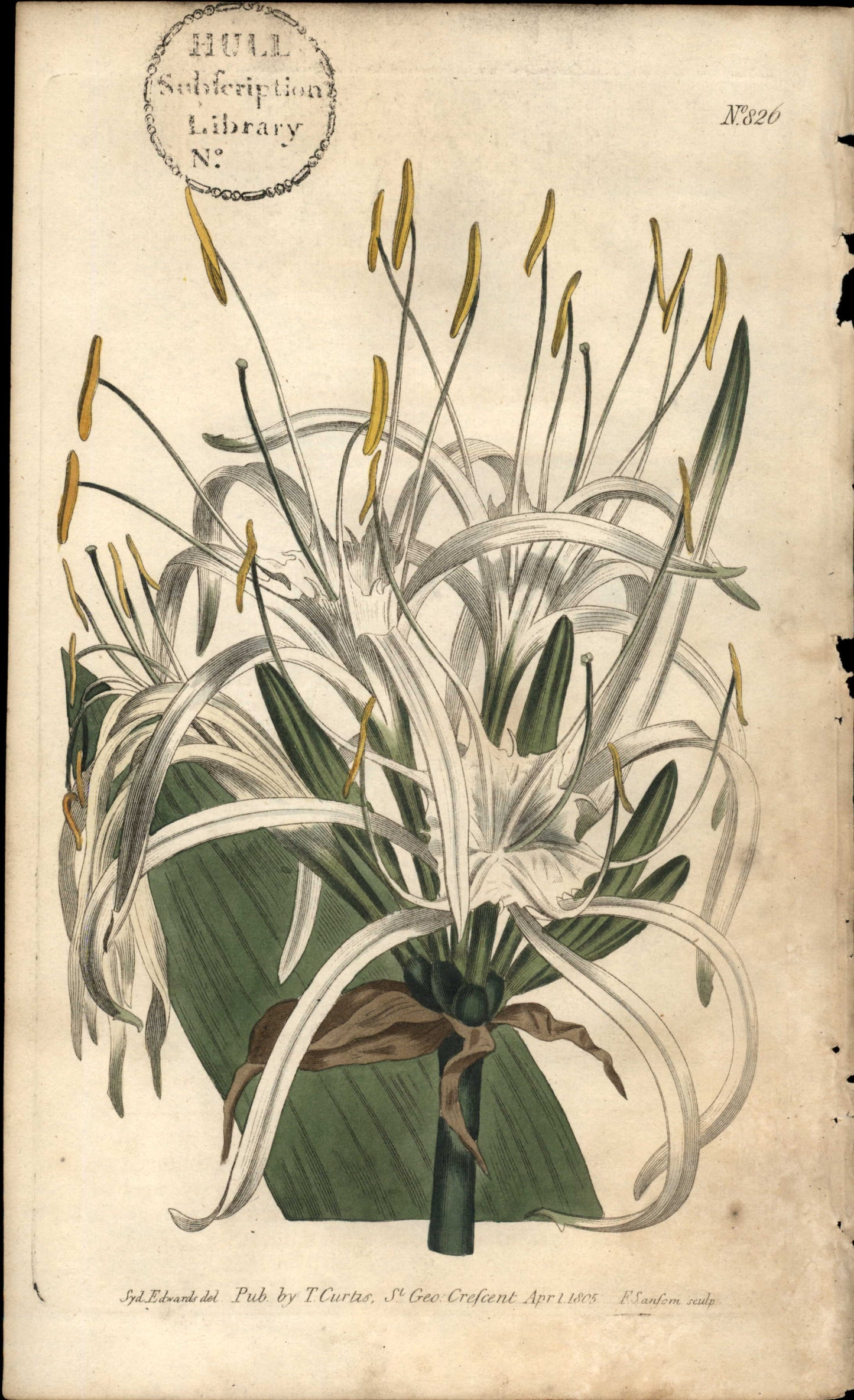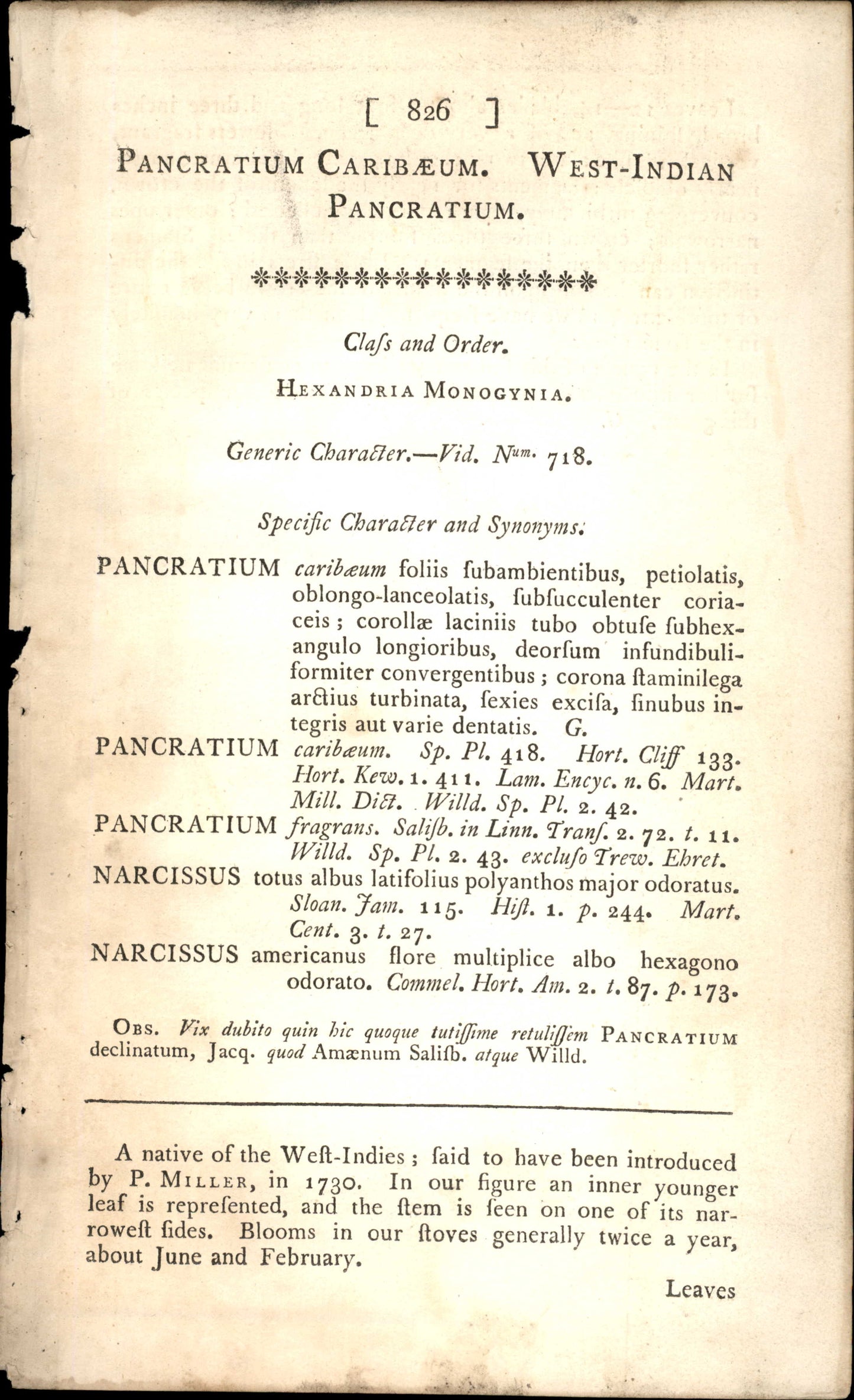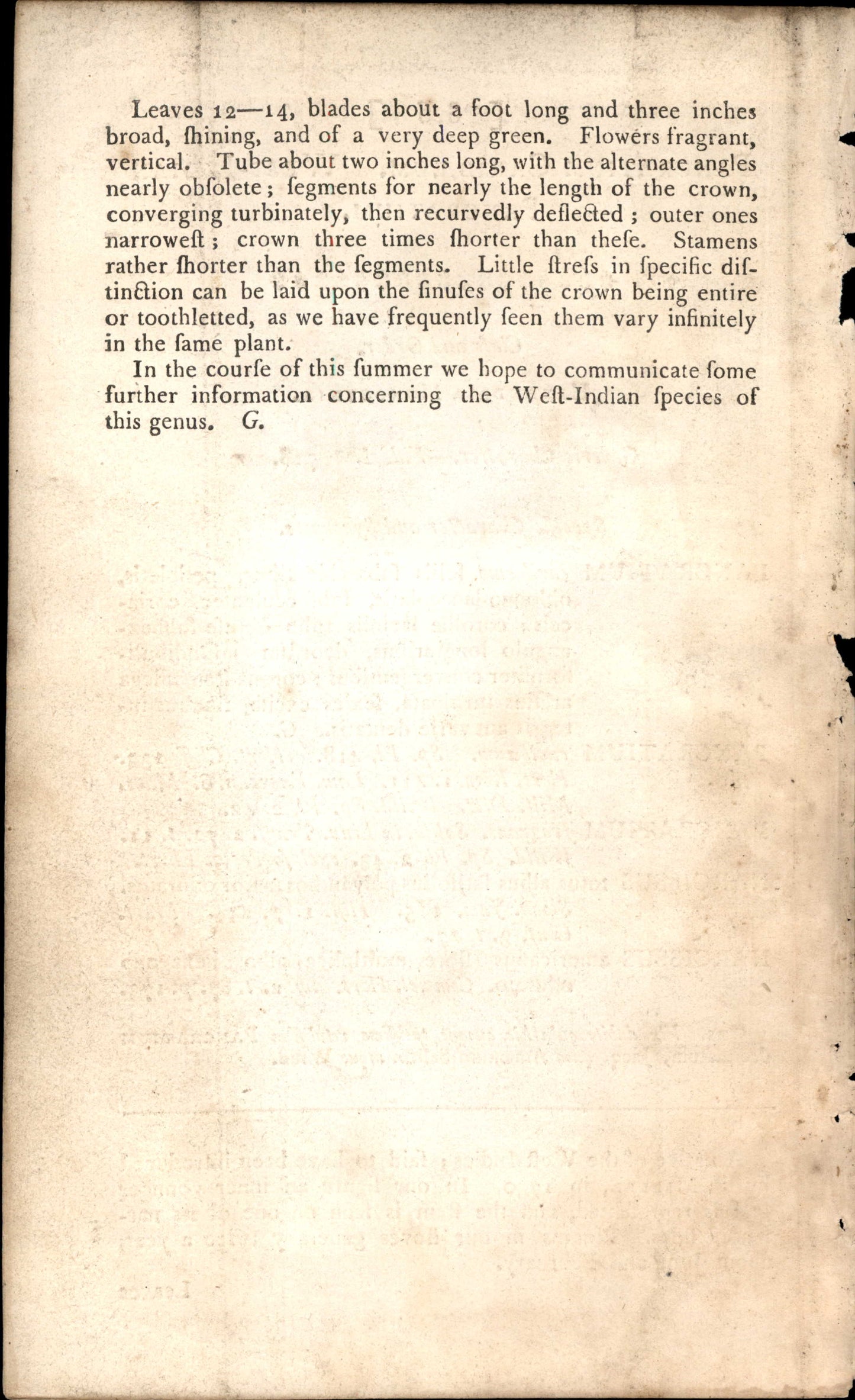Curtis Botanical Magazine
Plate 826 - West-indian Pancratium
Plate 826 - West-indian Pancratium
Couldn't load pickup availability
Plate 826
Classification: HEXANDRIA MONOGYNIA
Flowering Period: June
Publication Date: Apr 1, 1805
Description:
Complete Botanical Text (Cleaned)
HULL subfcription Library N° syd Edwards del Pub by TCurtis, S Geo: Crefcent Apr11805 ESanfem sculp N°826 [ 826 ] PANCRATIUM CARIBEUM.
WEsT-INDIAN PANCRATIUM. ******* Class and Order.
HEXANDRIA MONOGYNIA.
Generic Character.-Vid.
Num. 718. specific Character and synonyms: PANCRATIUM caribæum foliis fubambientibus, petiolatis, oblongo-lanceolatis, fubfucculenter coria- ceis; corollæ laciniis tubo obtuse fubhex- angulo longioribus, deorfum infundibuli- formiter convergentibus; corona ftaminilega arctius turbinata, fexies excifa, finubus in- tegris aut varie dentatis.
PANCRATIUM caribæum. sp.
Pl. 418.
G.
Hort.
Cliff 133.
Hort.
Kew. 1. 411.
Lam.
Encyc. n. 6.
Mart.
Mill.
Dict.
Willd. sp.
Pl. 2. 42.
PANCRATIUM fragrans.
Salib. in Linn.
Tranf. 2. 72. t. 11.
Willd. sp.
Pl. 2. 43. exclufo Trew.
Ehret.
NARCIsSUS totus albus latifolius polyanthos major odoratus. sloan.
Jam. 115.
Hift. 1. p. 244.
Cent. 3. t. 27.Mart.
NARCIsSUS americanus flore multiplice albo hexagono odorato.
Commel.Hort.Am. 2. t. 87. p. 173.OBS.
Vix dubito quin hic quoque tutiffime retuliffem PANCRATIUM declinatum, Jacq. quod Amænum Salifb. atque Willd.
A native of the Weft-Indies; faid to have been introduced by P.MILLER, in 1730.
In our figure an inner younger leaf is represented, and the stem is feen on one of its nar- roweft fides.
Blooms in our ftoves generally twice a year, about June and February.
Leaves Leaves 12-14, blades about a foot long and three inches broad, fhining, and of a very deep green.
Flowers fragrant, vertical.
Tube about two inches long, with the alternate angles nearly obfolete; segments for nearly the length of the crown, converging turbinately, then recurvedly deflected; outer ones narroweft; crown three times shorter than these. stamens rather shorter than the segments.
Little ftrefs in specific dif- tinction can be laid upon the finufes of the crown being entire or toothletted, as we have frequently feen them vary infinitely in the fame plant.
In the courfe of this summer we hope to communicate some further information concerning the Weft-Indian species of this genus.
G
Raw OCR Text (Original)
HULL subfcription Library N° syd Edwards del Pub by TCurtis, S Geo: Crefcent Apr11805 ESanfem sculp N°826 [ 826 ] PANCRATIUM CARIBEUM. WEsT-INDIAN PANCRATIUM. ******* Class and Order. HEXANDRIA MONOGYNIA. Generic Character.-Vid. Num. 718. specific Character and synonyms: PANCRATIUM caribæum foliis fubambientibus, petiolatis, oblongo-lanceolatis, fubfucculenter coria- ceis; corollæ laciniis tubo obtuse fubhex- angulo longioribus, deorfum infundibuli- formiter convergentibus; corona ftaminilega arctius turbinata, fexies excifa, finubus in- tegris aut varie dentatis. PANCRATIUM caribæum. sp. Pl. 418. G. Hort. Cliff 133. Hort. Kew. 1. 411. Lam. Encyc. n. 6. Mart. Mill. Dict. Willd. sp. Pl. 2. 42. PANCRATIUM fragrans. Salib. in Linn. Tranf. 2. 72. t. 11. Willd. sp. Pl. 2. 43. exclufo Trew. Ehret. NARCIsSUS totus albus latifolius polyanthos major odoratus. sloan. Jam. 115. Hift. 1. p. 244. Cent. 3. t. 27. Mart. NARCIsSUS americanus flore multiplice albo hexagono odorato. Commel. Hort. Am. 2. t. 87. p. 173. OBS. Vix dubito quin hic quoque tutiffime retuliffem PANCRATIUM declinatum, Jacq. quod Amænum Salifb. atque Willd. A native of the Weft-Indies; faid to have been introduced by P. MILLER, in 1730. In our figure an inner younger leaf is represented, and the stem is feen on one of its nar- roweft fides. Blooms in our ftoves generally twice a year, about June and February. Leaves Leaves 12-14, blades about a foot long and three inches broad, fhining, and of a very deep green. Flowers fragrant, vertical. Tube about two inches long, with the alternate angles nearly obfolete; segments for nearly the length of the crown, converging turbinately, then recurvedly deflected; outer ones narroweft; crown three times shorter than these. stamens rather shorter than the segments. Little ftrefs in specific dif- tinction can be laid upon the finufes of the crown being entire or toothletted, as we have frequently feen them vary infinitely in the fame plant. In the courfe of this summer we hope to communicate some further information concerning the Weft-Indian species of this genus. G.
Original botanical print from Curtis's Botanical Magazine
Share







